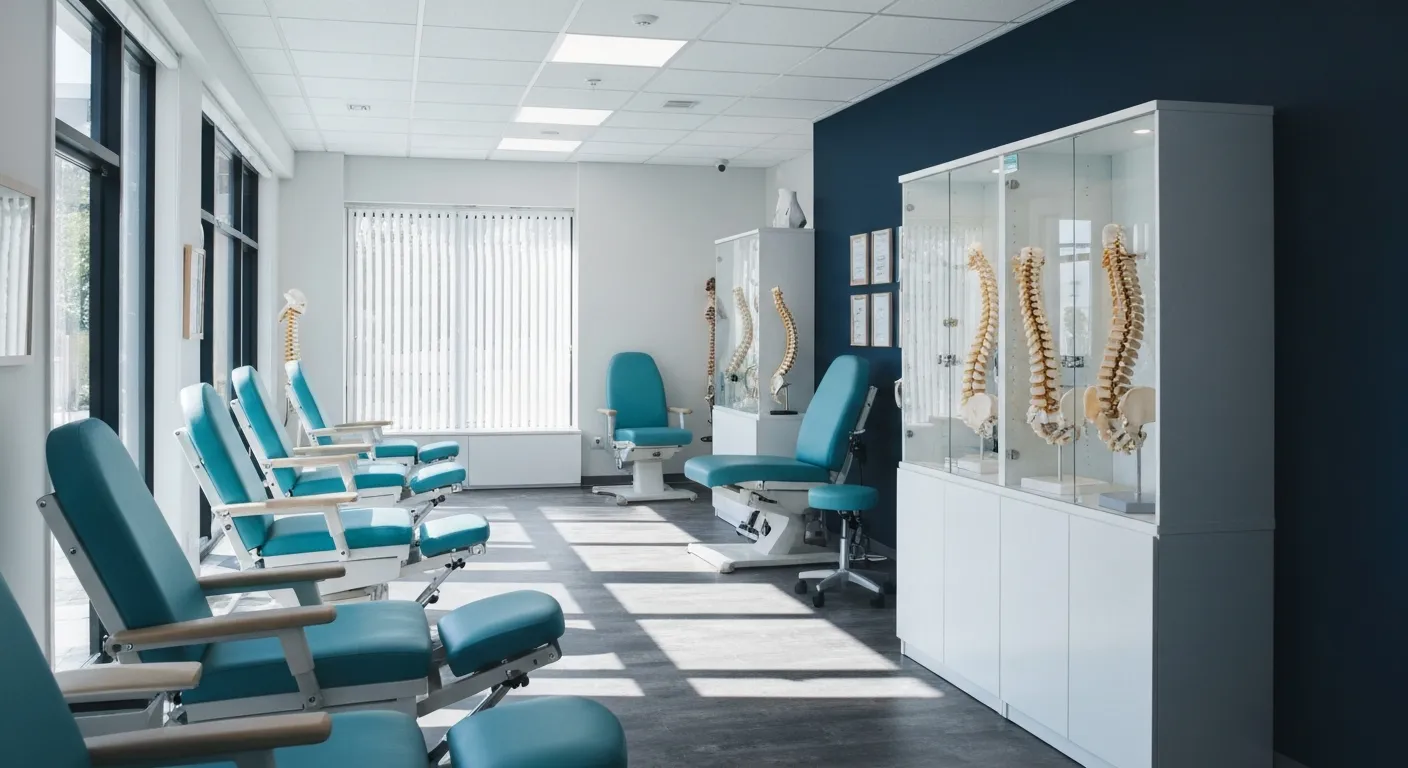First-Time Chiropractic Visitors: What You Should Know
October 29, 2025
11 min

Understanding Chiropractic Care and What to Expect
For many people experiencing musculoskeletal pain or seeking holistic health solutions, visiting a chiropractor for the first time can bring questions and uncertainties. Chiropractic care focuses on natural, hands-on methods to restore and enhance the body's joint function, posture, and overall nervous system health. This article offers a comprehensive overview to help first-time chiropractic visitors understand the process, prepare effectively, and maximize their experience during their initial appointment and beyond.
The Purpose and Benefits of Chiropractic Care

What is the main goal and philosophy of chiropractic care?
Chiropractic care focuses on restoring, maintaining, and optimizing health by improving joint function and increasing the range of motion, especially in the spine and extremities. This hands-on treatment method naturally enhances the interaction between the body's structure and the nervous system. It centers on the belief that spinal alignment affects overall health and that proper adjustments can support the body's innate ability to heal itself. For a comprehensive overview, see Comprehensive Guide to Chiropractic Health and learn about the holistic approach in chiropractic care.
What conditions does chiropractic care commonly address?
Chiropractors often treat conditions such as neck pain, back pain, headaches, sciatica, joint pain, and muscle stiffness. The care extends beyond pain relief to include improving posture, aiding muscle strength rebuilding after strokes, and alleviating issues related to nerve function. It targets neuromuscular disorders to restore proper structural alignment and alleviate discomfort. Learn more about Conditions Treated by Chiropractors, Chiropractic care for neck and back pain, and the holistic approach in chiropractic care.
What are the potential benefits of chiropractic treatment?
Chiropractic treatments can provide several health benefits, including significant pain relief, increased joint mobility, and better posture. They often reduce tension headaches and migraines and contribute to enhanced nervous system function. Furthermore, chiropractic care can lessen the dependence on pain medications such as opioids and facilitate overall wellness. Many patients report immediate relief and improved movement following treatment. For more information, refer to Benefits of Chiropractic Care, Pain Relief through Chiropractic Adjustments, and the holistic approach in chiropractic care.
Chiropractic care is a non-invasive, drug-free therapy option suitable for many individuals. It emphasizes holistic health by addressing root causes rather than only symptoms, making it a widely accepted approach to improving musculoskeletal and nervous system health while promoting long-term wellness. For an introduction to What to Expect at Your First Chiropractic Visit, insights into Non-invasive Pain Relief Options, and a holistic approach in chiropractic care, please see these resources.
Preparing for Your Initial Chiropractic Appointment

How should first-time patients prepare for their chiropractic visit?
Preparing for a first chiropractic appointment involves several important steps. Patients should bring relevant medical records, identification, insurance information, and any diagnostic test results such as recent X-rays. Wearing loose, comfortable clothing is essential since it facilitates physical examinations and allows for easier adjustments during treatment (Wearing Comfortable Clothing for Chiropractic). Arriving about 15 minutes early is advised to complete necessary paperwork and reduce appointment-day stress. Patients should also be ready to clearly describe their symptoms, pain history, lifestyle, and health habits to help the chiropractor tailor the care plan effectively (Preparation Tips for Your First Chiropractic Appointment.
What should patients expect during the initial consultation and exam?
The initial chiropractic consultation typically lasts between 30 to 60 minutes. It begins with a thorough discussion of medical history, including chronic conditions, injuries, medications, and lifestyle factors such as exercise and stressors. Chiropractors ask detailed questions about the onset, location, and nature of pain to understand the patient’s condition (Initial chiropractic consultation).
The physical exam includes checking blood pressure, pulse, reflexes, and assessments of muscle strength and neurological function. Posture analysis and range of motion tests evaluate spinal alignment and mobility discrepancies. Orthopedic and neurological tests may be performed to identify nerve irritation or musculoskeletal dysfunction (Physical Exam in Chiropractic Care, postural assessments for spinal misalignment). If necessary, diagnostic imaging like X-rays is used to reveal structural abnormalities or confirm a diagnosis. This comprehensive assessment helps formulate a personalized treatment plan.
The importance of patient communication
Clear communication between patient and chiropractor ensures a more accurate diagnosis and effective treatment. Sharing detailed information about symptoms, lifestyle, and previous treatments can help identify root causes. Patients are encouraged to ask questions about chiropractic techniques, treatment expectations, potential side effects, and costs (Questions to Ask Your Chiropractor). Open dialogue fosters trust, supports adherence to care plans, and contributes to better health outcomes. For a deeper understanding of the holistic approach in chiropractic care, patients can explore how chiropractic care integrates into overall wellness.
What Happens During Your First Chiropractic Visit

What takes place during the first chiropractic visit?
The initial chiropractic appointment begins with a detailed consultation where you discuss your health concerns, symptoms, and goals with the chiropractor. This is followed by a physical exam that assesses posture, joint function, reflexes, muscle strength, and neurological status. Sometimes, diagnostic tests such as X-rays are used to check for spinal deformities or recent injuries, but only when medically necessary. After gathering all this information, the chiropractor evaluates your condition comprehensively (First Chiropractic Visit Overview.
Are adjustments always done on the first visit?
Adjustments are not necessarily performed during the first appointment. Some chiropractors may proceed with spinal or joint manipulation if they identify an immediate problem, but many prefer to develop a personalized treatment plan first (Initial chiropractic consultation. This approach ensures the treatment is tailored to your specific needs and health status (Chiropractic diagnosis process. Whether an adjustment occurs or not, the chiropractor will explain the reasoning and possible next steps (Chiropractic adjustment overview).
Formulating a personalized treatment plan
Based on your exam and diagnostic results, the chiropractor creates an individualized plan targeting improved joint function, increased range of motion, and overall health optimization. The plan may include adjustments, exercises, posture correction, lifestyle advice, or other therapies depending on the severity and nature of your condition (Developing a chiropractic treatment plan, Chiropractic treatment plan formulation.
First treatments and adjustments
If appropriate, the first chiropractic treatment could involve manual spinal or joint manipulation, often characterized by a quick, controlled force applied to specific joints. These adjustments might produce popping or cracking sounds, which are normal and result from gas release within the joints (What to Expect During a Chiropractic Adjustment. Adjustments are generally painless but could cause mild soreness afterward (Common sensations after chiropractic adjustments.
What questions should first-time patients ask?
It's important to address any concerns by asking about the chiropractor’s credentials, the techniques used, expected treatment duration, costs, insurance coverage, and any potential risks or side effects of adjustments (Questions to Ask Your Chiropractor. Being informed helps you make confident decisions about your care and understand what to expect during the treatment process (Choosing the Right Chiropractor.
Understanding Chiropractic Adjustments and Techniques
What is involved in a chiropractic adjustment?
A chiropractic adjustment, also known as spinal manipulation, involves a licensed chiropractor applying a controlled, precise force to specific spinal or extremity joints. Typically, the patient lies on a specialized table during the procedure while the chiropractor uses their hands or a small instrument to realign the joints and improve motion. For more details, see Chiropractic adjustment overview and Chiropractic adjustment treatment.
What sensations or sounds might patients experience during adjustments?
Patients often hear popping or cracking sounds during an adjustment. These noises result from gas being released from the joints and are normal and painless. After the treatment, some might feel mild soreness or a warm, tingling sensation, akin to the feeling after physical exercise. Additional information is available at Understanding Chiropractic Adjustment Sounds and Popping and cracking sounds during adjustment.
What are the common chiropractic techniques used?
The most frequently used technique is the Diversified Technique, which uses a high-velocity, low-amplitude thrust to restore proper spinal alignment and movement. Other popular methods include:
- Spinal Mobilization: A gentler technique involving controlled movements within joint ranges, suitable for sensitive or elderly patients.
- Activator Method: Uses a handheld instrument to deliver light, rapid impulses to precise areas, minimizing muscle tension.
- Gonstead Technique: Focuses on specific spinal adjustments, done with the patient seated or lying on their side.
- Thompson Drop-Table Technique: Utilizes a special dropping table to assist the adjustment with less force.
- Flexion-Distraction Therapy: Employs a specialized table to stretch and decompress the spine, often used for disc-related issues.
For a detailed overview, read Chiropractic techniques and Common chiropractic techniques.
Are chiropractic adjustments safe?
Chiropractic care is generally safe when delivered by trained and licensed practitioners. Serious complications are very rare. Minor side effects such as temporary soreness, fatigue, headaches, or dizziness can occur but usually resolve within a short time. Proper patient screening is essential to identify any medical conditions that might contraindicate adjustments. See also Safety of chiropractic treatments and Safety of chiropractic adjustments.
What role do adjunct therapies and a holistic approach play?
Many chiropractors incorporate additional treatments like massage, electrical stimulation, heat/cold therapy, and exercise recommendations alongside adjustments. This holistic approach in chiropractic care aims to address underlying issues, promote overall wellness, and support long-term health beyond immediate symptom relief. More information can be found at Comprehensive Guide to Chiropractic Health and holistic approach in chiropractic care.
Post-Adjustment Expectations and Care
What Should Patients Expect After a Chiropractic Adjustment?
After a chiropractic adjustment, it is common to experience mild soreness, stiffness, or fatigue similar to what one might feel after physical exercise. These sensations typically last up to 24 hours. Most patients notice a reduction in muscle and joint tension, improved range of motion, and relief from pain soon after treatment. See more on Common Post-Adjustment Symptoms and Benefits and What to Expect During First Chiropractic Treatment.
What Side Effects Are Common and When Is Medical Attention Needed?
Common post-treatment effects can include slight headaches, nausea, or tiredness, but these are usually temporary and resolve quickly. Patients should seek medical attention or consult their chiropractor if they experience unusual or severe symptoms such as significant weakness, intense pain, numbness, or if symptoms worsen after the adjustment. Learn about Safety and Risks of Chiropractic Adjustments and When to Seek Medical Attention After Adjustment.
What Aftercare Is Recommended Following Chiropractic Treatment?
To support recovery and maintain the benefits of chiropractic care, patients are advised to stay well hydrated and avoid strenuous physical activity for at least 24 hours post-treatment. Resting adequately is important, alongside following any specific exercises or stretches recommended by the chiropractor. Lifestyle advice, including posture improvement and ergonomic adjustments, may be provided to promote long-term spinal health and prevent future issues. For detailed aftercare tips, see Post-Adjustment Care and Lifestyle Advice and Preparation Tips for Your First Chiropractic Appointment.
Recommended Follow-Up Care and Treatments
Chiropractors often develop personalized treatment plans that may include follow-up visits spaced according to individual needs. These can decrease in frequency as the patient's condition improves. Additional therapies such as massage, heat or cold application, and relaxation techniques may be combined with chiropractic adjustments for enhanced recovery. Explore Chiropractic Treatment Plans and Follow-Up Care and Additional Therapies to Complement Chiropractic Care.
Home Exercises and Lifestyle Advice
Patients are frequently encouraged to perform gentle stretches and strengthening exercises at home to complement chiropractic treatments. Maintaining proper hydration, practicing good posture, and adopting ergonomic habits are key lifestyle factors that support ongoing spinal health and reduce the risk of recurrence. More information is available in Home Exercises After Chiropractic Adjustment and Lifestyle Advice for Spinal Health.
Choosing the Right Chiropractor and Treatment Plan

How can patients choose a qualified chiropractor?
Choosing the right chiropractor starts with verifying their education, licensing, and professional experience. Patients should check credentials and state board certifications to ensure proper training and legal compliance. Looking up online reviews and asking for personal recommendations can provide insight into patient satisfaction and clinic reputation. Scheduling an initial consultation helps patients discuss the chiropractor's treatment philosophy and ensures comfort with their approach.
What factors influence the treatment plan?
Treatment plans are tailored to each individual based on detailed medical history, severity and nature of the condition, and lifestyle factors. Chiropractors consider patient goals and symptoms when designing a care schedule, which usually involves more frequent visits initially, gradually decreasing as progress is made. Various chiropractic techniques and adjunct therapies may be incorporated depending on the patient's specific needs.
Why is patient communication important?
Open and honest communication between the patient and chiropractor is crucial. It enables the practitioner to adjust treatments based on patient feedback, address any concerns early, and set realistic expectations. This collaborative relationship fosters trust and encourages adherence to the treatment plan, greatly improving the chance of successful outcomes.
Insurance and cost considerations
Before beginning care, patients should inquire about insurance coverage and out-of-pocket costs. Understanding what services are covered and any financial responsibilities can help avoid surprises. Many chiropractors provide transparent cost information and work with insurance providers to facilitate claims, as discussed in insurance coverage for chiropractic care.
Tailoring treatment to individual needs
Every patient is unique, and effective chiropractic care reflects this by customizing techniques and treatment duration. Factors such as age, overall health, and specific symptoms influence the approach. A personalized care plan ensures that therapy maximizes benefits while minimizing risks and discomfort. For more information on tailoring chiropractic treatment plans, see relevant guidelines and best practices.
Holistic and Long-Term Benefits of Chiropractic Care

How does chiropractic care support holistic health?
Chiropractic care focuses on more than just alleviating pain. Chiropractors assess posture, nervous system health, and lifestyle factors to treat the whole person. Alongside manual adjustments, they often use adjunct therapies such as massage, electrical stimulation, heat/cold treatments, and recommend exercises and nutritional guidance. This holistic approach in chiropractic care helps optimize overall well-being and prevents future problems (Comprehensive Guide to Chiropractic Health, Chiropractic care overview).
Can chiropractic care reduce reliance on medications?
Yes, chiropractic care offers a drug-free alternative that effectively manages pain and inflammation. Research indicates that adults receiving chiropractic treatment for back and neck pain often reduce their use of opioid pain medications. By addressing underlying musculoskeletal issues naturally, chiropractic therapy helps decrease dependence on pharmaceuticals (Chiropractic care for pain relief, Chiropractic vs opioids).
What are some long-term benefits beyond pain relief?
Beyond immediate symptom relief, chiropractic patients may experience improved posture and spinal alignment, which alleviates strain on muscles and joints. Enhanced nervous system function supports better health overall. Increased joint mobility and flexibility can contribute to injury prevention. Additionally, many report better sleep quality and reduced stress levels. Some athletes also benefit from improved performance and quicker recovery through regular chiropractic care (Benefits of Chiropractic Care, Chiropractic adjustment overview.
Chiropractic care, therefore, serves as a holistic approach in chiropractic care, sustained wellness strategy rather than a simple pain treatment, integrating physical adjustments with lifestyle education for long-term health improvements (Chiropractic care benefits, Holistic Health and Neuromuscular Disorders).
Making the Most of Your First Chiropractic Experience
Visiting a chiropractor for the first time can be a positive step toward addressing pain, improving mobility, and enhancing overall wellness. Understanding the purpose, what to expect during the initial appointment, the nature of chiropractic adjustments, and post-treatment care helps patients feel confident and prepared. Choosing a qualified chiropractor and maintaining open communication are key to receiving personalized, safe, and effective care. With a holistic approach targeting the roots of musculoskeletal issues, chiropractic care offers a valuable, drug-free option for many seeking health improvement and pain relief.
Recent articles

Long-Term Pain Relief Through Targeted Corrective Exercises

10 Benefits of Integrating Physiotherapy with Chiropractic Treatments

Corrective Exercises That Help Prevent Recurring Pain

8 Corrective Exercises Proven for Lasting Pain Relief

Lifestyle Habits for Maintaining a Healthy Spine

What You Will Experience at Your Initial Chiropractic Visit

What Happens at Your First Visit to a Chiropractor?

Focusing on Root Cause Analysis for Effective Pain Relief

Tips for Lifestyle Changes to Support Spinal Health

Holistic Treatment Plans: Alternatives to Surgery for Chronic Pain

Enhance Wellness Through Personalized Nutritional Counseling

Non-Invasive Pain Relief: Exploring Holistic Treatment Alternatives

Sciatica Relief Through Targeted Spinal Decompression

Integrating Physiotherapy with Chiropractic Treatments for Better Results

Testimonials That Demonstrate the Benefits of Chiropractic Care

The Power of Corrective Exercises in Pain Management

A Step-by-Step Guide to Your Initial Chiropractic Consultation

9 Nutritional Tips to Enhance Your Chiropractic Wellness Journey

Patient Experiences: How Chiropractic Care Changed Their Lives

Lifestyle Recommendations to Keep Your Spine in Top Shape

Effective Corrective Exercises for Long-Term Pain Relief

Back Pain Benefits: What Chiropractic Care Can Do for You

Spinal Decompression Techniques for Effective Sciatica Relief

Top Nutritional Counseling Tips for Enhanced Wellness

6 Lifestyle Habits That Boost Spine Health Daily

Discover Holistic and Non-Surgical Pain Relief Solutions

Exploring Holistic and Non-Surgical Treatment Options for Pain

The Role of Physiotherapy in Enhancing Chiropractic Care Outcomes

Complementing Chiropractic Care with Physiotherapy: What You Need to Know

What to Expect During Your First Chiropractic Visit

Simple Lifestyle Adjustments to Maintain a Healthy Spine

Personalized Nutritional Counseling for Improved Health Outcomes

Exploring Non-Surgical Treatments for Spine-Related Conditions

An Introduction to Spinal Decompression for Sciatica Patients

Transformative Success Stories: Patient Experiences with Chiropractic Treatments

Why Chiropractic Care Is Essential for Back Pain Relief

Addressing Underlying Causes Versus Symptom Management in Pain Care

The Role of Nutrition in Enhancing Chiropractic Treatment Effectiveness

Sciatica Treatment Options: Is Spinal Decompression Right for You?

Lifestyle Tips to Maintain a Healthy Spine and Prevent Back Issues

The Synergy Between Physiotherapy and Chiropractic Treatments

What Happens During Your Initial Chiropractic Consultation

Effective Corrective Exercises for Sustainable Pain Management

Taking a Root Cause Approach to Chronic Pain Management

Holistic Pain Management Techniques Without Surgery

How Patient Success Stories Validate Chiropractic Care Benefits

Spinal Decompression: Innovative Treatment for Sciatic Nerve Pain

Spinal Decompression Therapy: A Non-Invasive Approach to Sciatica Relief

Exploring Holistic Approaches Beyond Surgery for Pain Relief

Practical Lifestyle Advice to Support a Healthy Spine Every Day

Corrective Exercise Routines Designed for Long-Term Pain Prevention

Real Patient Stories: Overcoming Chronic Pain with Chiropractic Care

Lifestyle Changes That Promote a Healthy Spine and Prevent Injury

How Addressing the Root Cause of Pain Leads to Lasting Relief

Non-Surgical Holistic Therapies to Manage Chronic Pain Effectively

Nutritional Counseling's Impact on Physical Health and Healing

Benefits of Regular Chiropractic Care for a Stronger Back

Your First Chiropractic Visit: What to Expect and How to Prepare

Patient Experiences: How Chiropractic Care Transformed Their Lives

Exploring Holistic, Non-Surgical Options for Pain Management

Combining Physiotherapy with Chiropractic Treatments for Enhanced Recovery

Holistic Treatments That Offer Alternatives to Surgery for Pain Relief

Corrective Exercise Strategies for Long-Term Spine Health

How Physiotherapy Complements Chiropractic Adjustments for Better Outcomes

First-Time Chiropractic Visitors: What You Should Know

Understanding the Importance of Treating Pain at Its Source

Adopting Lifestyle Changes to Support Your Spine's Wellness

Utilizing Physiotherapy to Enhance Chiropractic Treatment Outcomes

The Key Advantages of Chiropractic Care for Back Pain Sufferers

Why Focusing on Root Causes Improves Pain Treatment Success

Corrective Exercises That Promote Lasting Pain Relief and Mobility

Sciatica Relief Through Targeted Spinal Decompression Techniques

Preparing for Your First Chiropractic Appointment with Confidence

Healthy Lifestyle Habits for Maintaining Spinal Alignment

Success Stories Highlighting Chiropractic's Role in Pain Recovery

Top Benefits of Chiropractic Care for Chronic Back Pain

Nutrition Tips to Boost Your Overall Wellness and Recovery

How Chiropractic Care Alleviates Back Pain Naturally

How Nutritional Counseling Supports Overall Wellness and Spine Health

Step-by-Step Guide to Your First Visit with a Chiropractor

Using Nutrition to Support Chiropractic and Overall Wellness

Integrating Physiotherapy in Your Chiropractic Healing Journey

How Physiotherapy Complements Chiropractic Adjustments for Faster Healing

Lifestyle Tips for Maintaining a Healthy Spine and Preventing Back Pain

Heartwarming Patient Testimonials Highlighting Chiropractic Success

How Proper Nutrition Supports Chiropractic and Physiotherapy Treatments

Combining Physiotherapy and Chiropractic Treatments for Optimal Recovery

Why Chiropractic Treatments Are Effective for Managing Back Pain

Choosing a Chiropractor: Tips for Finding a Trusted Provider

Integrating Physiotherapy and Chiropractic: Benefits and What to Expect

How Tailored Corrective Exercises Can Aid in Pain Management

Chiropractic Care: A Proven Solution for Alleviating Back Pain

What to Expect at Your First Chiropractic Visit: A Comprehensive Guide

The Importance of Root Cause Analysis in Effective Pain Management

The Role of Corrective Exercises in Sustaining Pain-Free Living

Combining Chiropractic and Physiotherapy for Comprehensive Pain Relief

How Addressing Underlying Causes Improves Pain Treatment Effectiveness

Maintaining Spinal Health Through Lifestyle Changes and Preventive Care

Understanding the Benefits of Chiropractic Adjustments for Back Pain Sufferers

